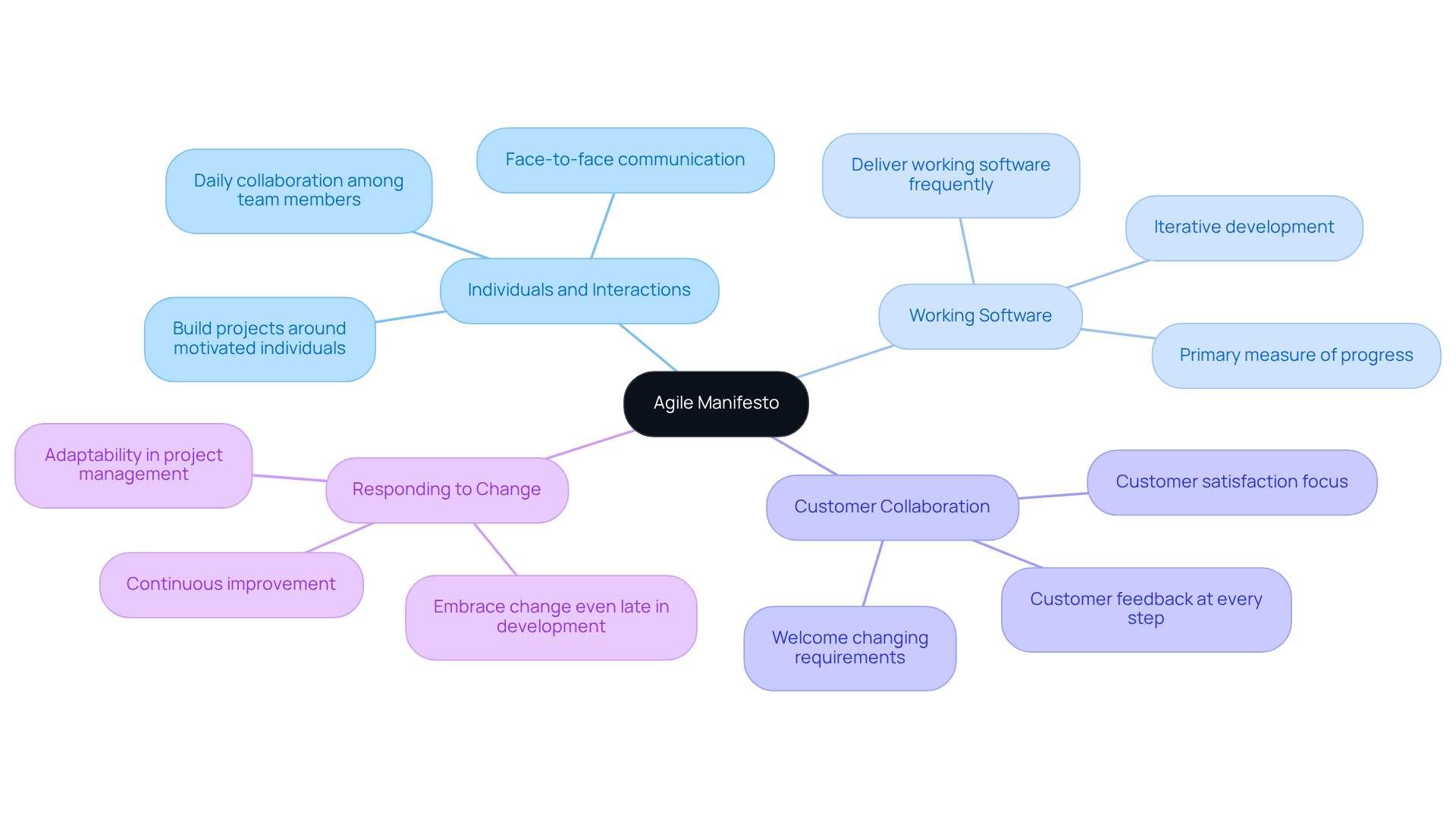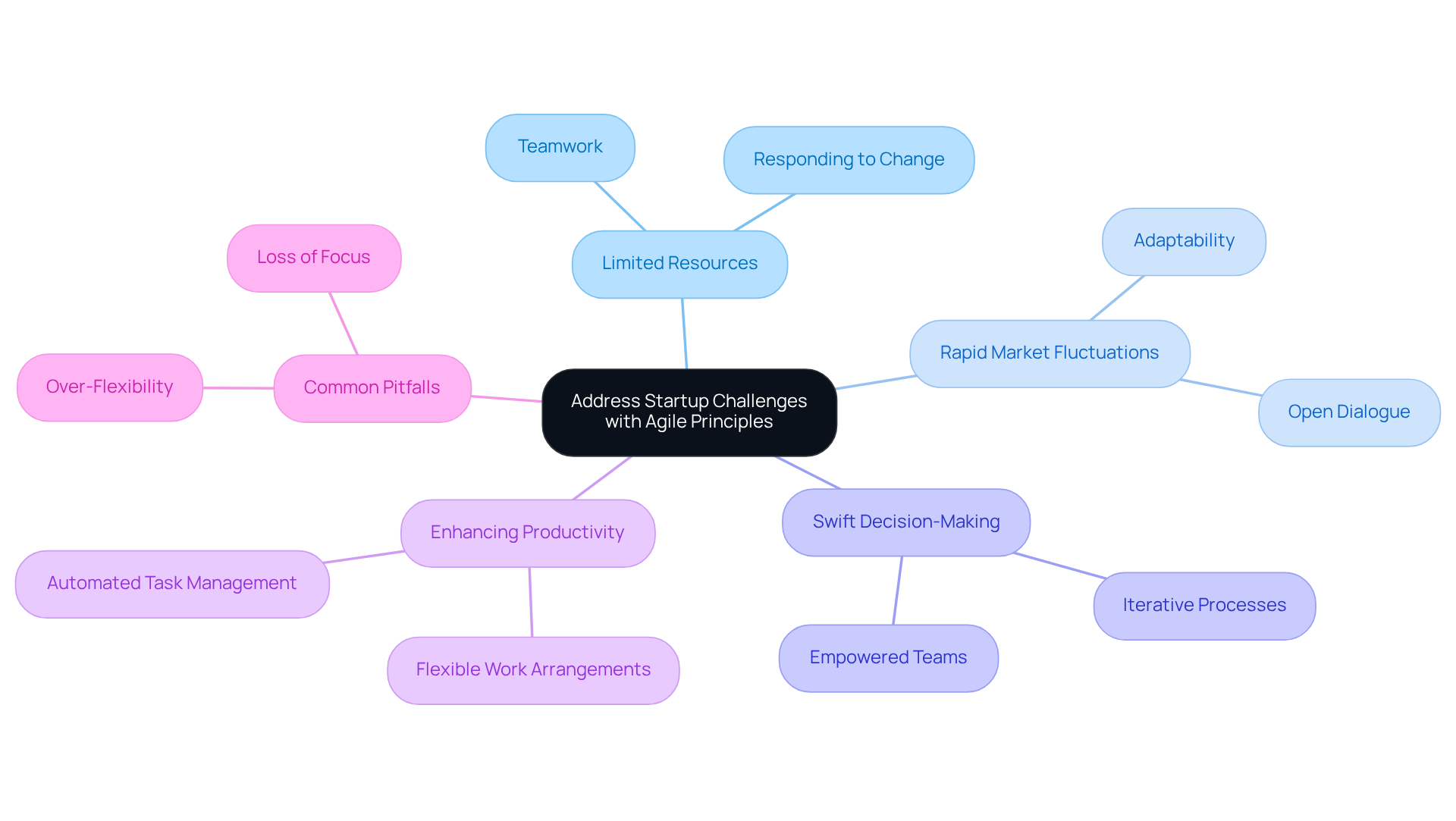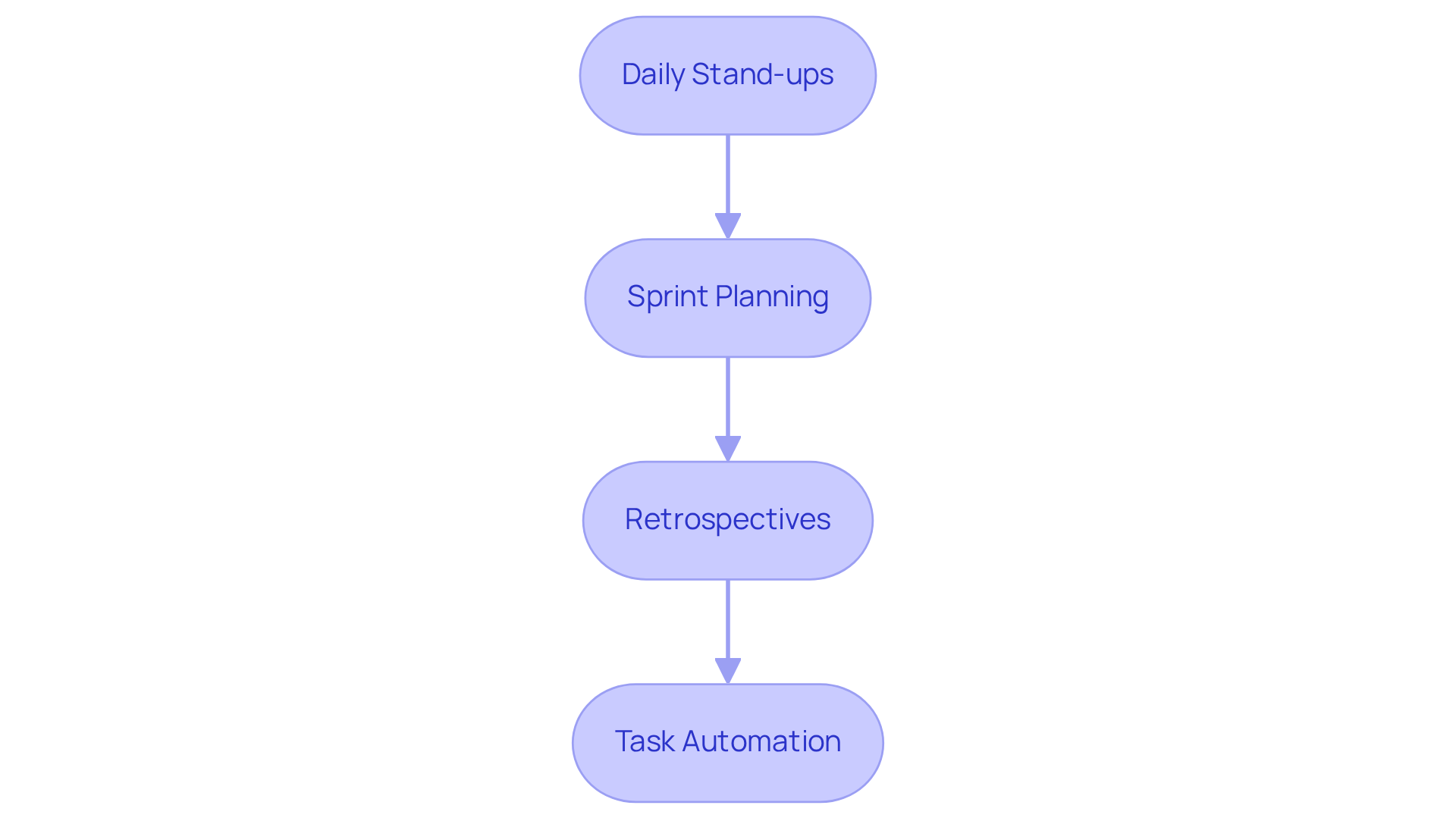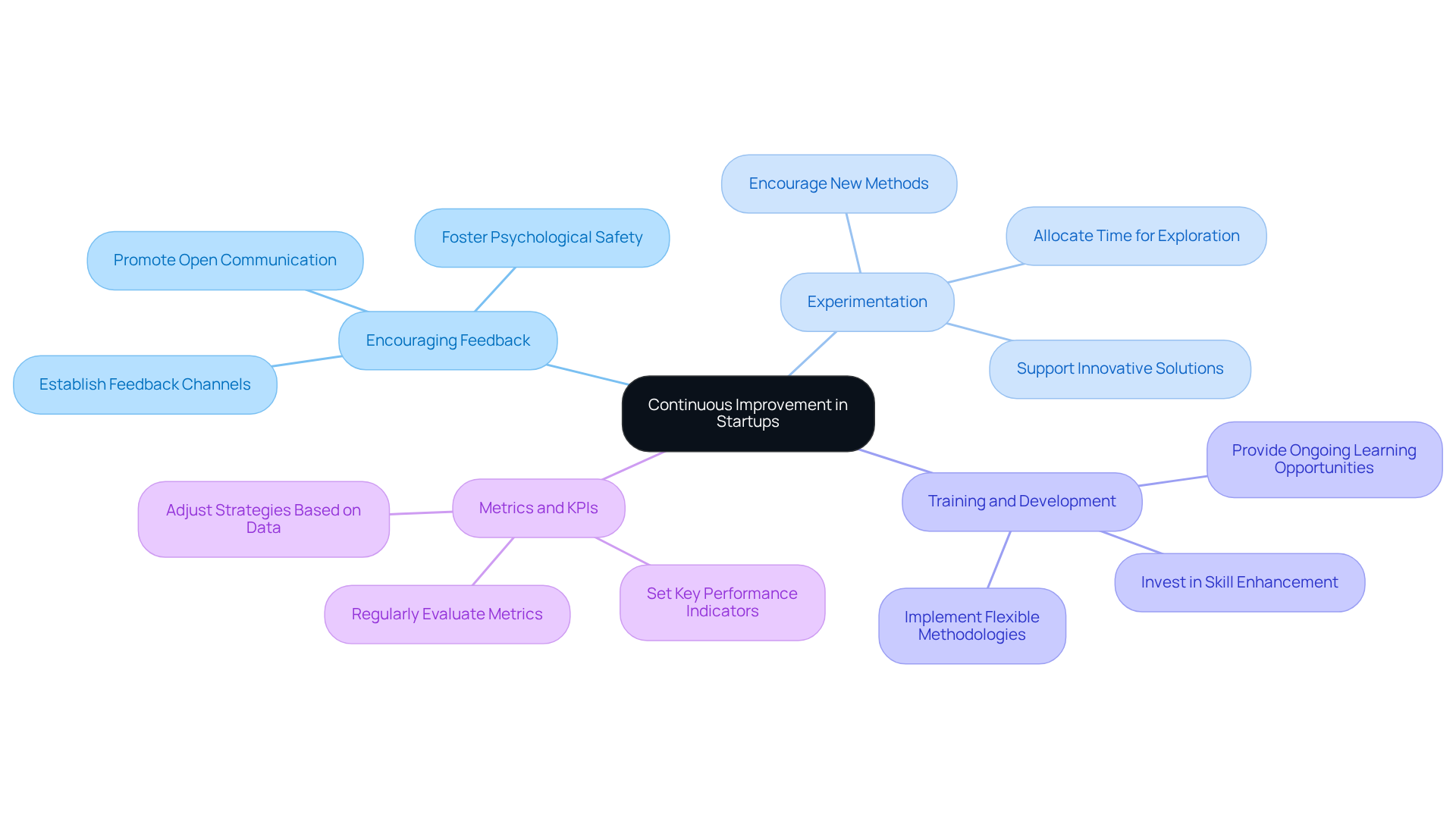Overview
The article explores how startups can effectively leverage four key principles from the Agile Manifesto to navigate their unique challenges, such as limited resources and rapid market changes. By emphasizing collaboration, adaptability, and continuous improvement, these principles empower startups to respond swiftly to customer needs. This not only enhances operational efficiency but also significantly increases their chances of success in competitive environments.
Are you ready to transform your startup's approach? By adopting these Agile principles, you can create a more responsive and resilient organization. The ability to adapt quickly to market demands is crucial in today’s fast-paced landscape. As startups embrace these strategies, they position themselves to thrive amidst uncertainty and competition.
Ultimately, the integration of these Agile principles can lead to sustainable growth and a stronger market presence. Startups that prioritize these values are not just surviving; they are setting themselves up for long-term success. Embrace the Agile mindset and watch your startup flourish.
Introduction
The landscape of entrepreneurship presents numerous challenges, ranging from limited resources to the relentless pace of market changes. Amidst this chaos, the Agile Manifesto stands out as a beacon of hope, offering principles that empower startups to navigate these turbulent waters with agility and resilience.
By embracing these core values, new ventures can:
- Enhance collaboration
- Foster innovation
- Respond swiftly to customer needs
Yet, the pressing question remains: how can startups effectively implement these Agile principles to not only survive but thrive in competitive environments?
Understand the Agile Manifesto: Core Values and Principles
The agile manifesto principles are articulated in the Manifesto for Development, which lays out four fundamental values and twelve principles that prioritize people and interactions, functioning software, collaboration with customers, and adaptability to change. For new businesses, understanding these values is essential, as they underscore the importance of agility and responsiveness in dynamic environments. The Agile Alliance, boasting around 90,000 members, highlights the widespread adoption of Agile practices across various industries, further emphasizing their relevance in today's business landscape. By concentrating on delivering value to customers and adjusting to their needs, startups can develop products that resonate more effectively with their target audience.
The agile manifesto principles advocate for teams to prioritize collaboration, embrace change, and consistently reflect on their processes, nurturing a culture of innovation and continuous improvement. As noted by the Business Consortium, "Individuals and interactions over processes and tools," which underscores the critical role of collaboration in flexible methodologies.
Consider a new company developing a cutting-edge app; by applying these principles, they can iterate swiftly based on user feedback, ensuring that the final product aligns closely with market demands. This method not only boosts customer satisfaction but also mitigates the risk of costly errors in product development. However, it is crucial for new ventures to recognize that the transformation process requires time, commitment, and patience. Understanding the difference between 'doing agile' and 'being agile' is vital to avoid common pitfalls in Agile implementation. By embracing the agile manifesto principles, startups can significantly enhance their chances of success.

Address Startup Challenges with Agile Principles
Startups frequently encounter significant challenges, including limited resources, rapid market fluctuations, and the necessity for swift decision-making. The agile manifesto principles provide a compelling solution by promoting an adaptable project management approach. For instance, the agile manifesto principles, such as 'responding to change over following a plan,' empower teams to quickly adjust to shifting market conditions, enabling them to capitalize on new opportunities or mitigate emerging threats. A study reveals that remote enterprises experienced a remarkable 46% increase in productivity due to flexible work arrangements, underscoring the effectiveness of Agile methodologies in enhancing operational efficiency.
Moreover, the emphasis on teamwork and open dialogue greatly reduces the chances of misalignment and miscommunication, which often obstruct new ventures. By cultivating an environment where team members feel encouraged to share ideas and provide feedback, these ventures can enhance their problem-solving capabilities and drive innovation. A notable example is a marketing startup that adopted flexible methodologies to refine their campaign development process, resulting in quicker turnaround times and heightened client satisfaction. This adaptability not only boosts operational efficiency but also enables emerging businesses to thrive in competitive landscapes.
However, it is vital to remain vigilant about common pitfalls in iterative project management, such as the risk of becoming overly flexible and losing sight of project objectives. By striking a balance between adaptability and focus, new ventures can effectively harness the agile manifesto principles to navigate their unique challenges.

Implement Agile Practices: Strategies for Startups
To implement agile practices effectively, startups can adopt several strategies that enhance collaboration and drive better outcomes:
- Daily Stand-ups: Conduct brief daily meetings to discuss progress, challenges, and plans for the day. This fosters accountability and keeps everyone aligned.
- Sprint Planning: Organize work into sprints, typically lasting two to four weeks, where specific goals are set. This enables groups to concentrate on providing incremental value and regularly reevaluate priorities.
- Retrospectives: After each sprint, hold a retrospective meeting to reflect on what went well and what could be improved. This promotes a culture of continuous improvement and learning.
- Task Automation: Utilize tools like Casy to automate task creation and updates based on group discussions. This decreases administrative burden and enables groups to concentrate on high-value activities.
By implementing these strategies, startups can create a more agile environment that enhances collaboration and accelerates decision-making in line with the agile manifesto principles, ultimately driving better outcomes. Are you ready to transform your startup's approach to agility?

Foster Continuous Improvement: Adapting Agile in a Startup Context
Fostering a culture of continuous improvement is essential for startups, as it involves regularly evaluating processes and outcomes to identify areas for enhancement. How can startups achieve this? By implementing the following strategies:
- Encouraging Feedback: Establish avenues for team members to provide input on processes and practices. This approach can yield valuable insights and innovative solutions.
- Experimentation: Motivate teams to explore new methods and tools. Engaging in experimentation can uncover more efficient ways of working and cultivate a culture of innovation.
- Training and Development: Invest in training programs that enhance team members' skills in flexible methodologies and associated tools. This investment ensures the team is well-equipped to adapt to changing circumstances.
- Metrics and KPIs: Set key performance indicators (KPIs) to measure progress and success. Consistently evaluate these metrics to assess the effectiveness of flexible methodologies and make necessary adjustments.
By embedding continuous improvement into their culture, startups can remain agile and responsive to market changes, which reflects the agile manifesto principles and ultimately drives sustained growth and success.

Conclusion
Understanding and implementing the Agile Manifesto principles can significantly empower startups to navigate the complexities of their environments. By prioritizing adaptability, collaboration, and continuous improvement, new ventures can position themselves to respond effectively to challenges and capitalize on opportunities. Embracing these principles not only enhances operational efficiency but also fosters a culture where innovation thrives.
The article highlights several key strategies for startups, including:
- Daily stand-ups
- Sprint planning
- Retrospectives
These methods collectively create a framework for effective agile practices, encouraging accountability and alignment within teams while promoting a mindset of learning and growth. Additionally, by focusing on continuous improvement and fostering open communication, startups can better align their efforts with customer needs, ultimately leading to greater satisfaction and success.
In a rapidly evolving business landscape, the significance of adopting agile methodologies cannot be overstated. Startups are encouraged to take actionable steps toward integrating these principles into their operations. By doing so, they not only enhance their resilience but also set the stage for sustained growth and innovation. Embracing agility is not merely a strategy; it is a transformative approach that can redefine a startup's trajectory in today's competitive market.
Frequently Asked Questions
What is the Agile Manifesto?
The Agile Manifesto is a framework that outlines four fundamental values and twelve principles aimed at prioritizing people and interactions, functioning software, collaboration with customers, and adaptability to change.
Why is understanding the Agile Manifesto important for new businesses?
Understanding the Agile Manifesto is essential for new businesses as it emphasizes the importance of agility and responsiveness in dynamic environments, helping them to develop products that resonate with their target audience.
What are the four core values of the Agile Manifesto?
The four core values of the Agile Manifesto prioritize: individuals and interactions over processes and tools, working software over comprehensive documentation, customer collaboration over contract negotiation, and responding to change over following a plan.
How many members does the Agile Alliance have?
The Agile Alliance has around 90,000 members, reflecting the widespread adoption of Agile practices across various industries.
What benefits do startups gain from applying Agile principles?
By applying Agile principles, startups can iterate quickly based on user feedback, ensuring their products align closely with market demands, which boosts customer satisfaction and reduces the risk of costly errors in product development.
What is the difference between 'doing agile' and 'being agile'?
'Doing agile' refers to merely following Agile practices without fully embracing the underlying principles, while 'being agile' involves a deeper cultural shift towards continuous improvement, collaboration, and adaptability.
What is required for a successful transformation to Agile practices?
Successful transformation to Agile practices requires time, commitment, and patience from teams and organizations.




